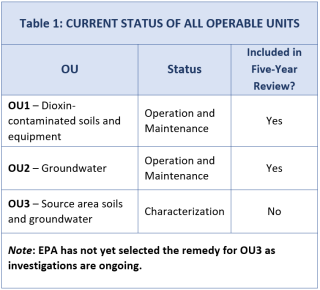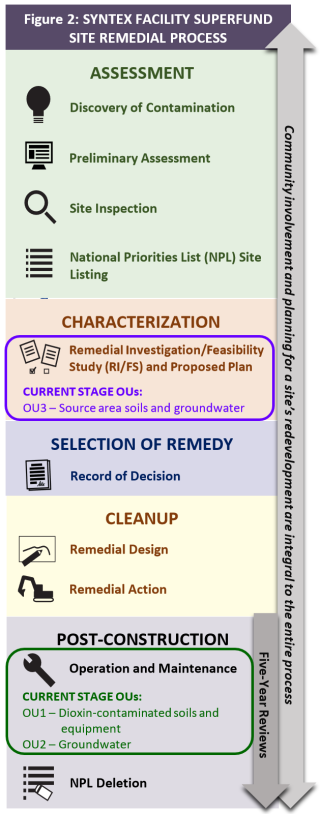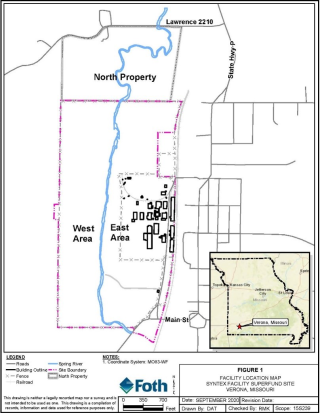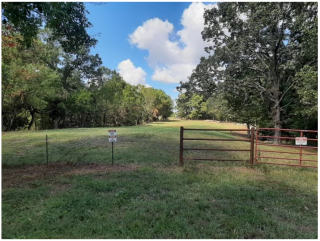Syntex Facility Superfund Site, Verona, Lawrence County, Missouri - Fact Sheet, February 2023
Community Update – Sixth Five-Year Review Summary
In this Community Update:
- Site Overview and Selected Remedies
- Five-Year Review Process
- Five-Year Review Findings
- Five-Year Review Protectiveness Determinations
- Current Status and Next Steps
Introduction
Five-Year Reviews (FYRs) provide an opportunity to evaluate the implementation and performance of a remedy and to determine whether a remedy is protective of human health and the environment. FYR reports identify issues and make recommendations to improve the site’s cleanup. EPA conducts these reviews every five years. EPA completed the Sixth FYR for the Syntex Facility Superfund Site (site) in September 2022. This Community Update provides an overview of this FYR.
Site Overview
The site covers approximately 180 acres and is located west of Verona in Lawrence County, Missouri. In the 1960s, Hoffman-Taff Inc. owned and operated a facility to manufacture 2,4,5-trichlorophenoxy-acetic acid (also known as 2,4,5-T) for the U.S. Army. The chemical 2,4,5-T is one component of the defoliant commonly referred to as Agent Orange. Between 1969 and 1972, Northeastern Pharmaceutical and Chemical Company (NEPACCO) leased a portion of the facility to manufacture hexachlorophene. Syntex purchased the facility in December 1969.
Dioxin (2,3,7,8-tetrachlorodibenzo-p-dioxin) was created as an unwanted byproduct in the production of 2,4,5-T and hexachlorophene. Manufacturing waste residues were released and disposed on the property, contaminating the soil and groundwater with dioxin and other contaminants. For additional information about dioxin, visit ATSDR’s Toxicity FAQs (ToxFAQs™).
Syntex owned and operated the facility until 1996, manufacturing choline chloride and other food additives for both human and animal consumption. DuCoa LP purchased the east portion of the property from Syntex and then sold the property to the current owner/operator, BCP Ingredients Inc. (BCP) in 2001. BCP manufactures choline chloride and repackages bulk ethylene oxide.
EPA divided the site into three focus/project areas, or Operable Units (OUs). Table 1 (on Page 3) summarizes the OUs and their status in the Superfund cleanup process.
Selected Remedies and Cleanup
EPA selected remedies for OU1 and OU2 in Records of Decision (RODs). The next paragraphs summarize the major parts of the remedies for these OUs. Since 1980, federal and Potentially Responsible Party actions have been taken to assess and address contamination at the site.
For a glossary of Superfund Terms, visit EPA's website.
OU1 (Dioxin-contaminated soils and equipment):
The remedy, selected in the 1988 ROD, included excavation and incineration of soils containing 20 parts per billion (ppb) or greater, as determined using a statistical protocol. Soils found to be contaminated were to be excavated in lifts, up to a maximum of 4 feet deep or to bedrock or until soils contained less than 20 ppb, whichever came first. The remedy also included decontamination of equipment, capping and/or vegetative covers over certain areas.
Between 1988 and 1990, and in accordance with the ROD, the dioxin-contaminated surface soils were excavated and incinerated, and certain areas were capped and/or vegetative covers were established. Disposal of the contaminated equipment was completed in 1996.
OU2 (Groundwater):
The remedy, selected in the 1993 ROD, called for “no further remedial action” for groundwater at the site, since off-site contamination was within the range of relevant EPA standards at that time. The remedy did include additional groundwater monitoring and surface water sampling of Spring River, as well as a risk assessment at the conclusion of the additional sampling.
Syntex collected groundwater samples from East Area monitoring wells twice a year from November 1997 through August 1999 and submitted a risk assessment, which concluded that there was not a complete exposure pathway because the groundwater discharged to the Spring River surface water did not exceed acceptable levels. Between 2003 and 2012, Syntex continued periodically collecting groundwater samples.
Five-Year Review Process

During the FYR process, EPA visited the site, inspected cleanup areas, and evaluated the environmental data collected for the site over the previous five years. EPA also looked at the action levels and cleanup levels used during cleanup activities to see if they are still considered protective today, based on any recent changes in regulatory standards or health-based criteria. As part of the FYR process, EPA published a notice in the Monett Times on Sept. 1, 2021, to inform the community that the FYR would be taking place.
The 2022 FYR addresses OU1 and OU2. The FYR evaluates only those OUs that have a remedy in place and where remedy construction has started. The FYR does not evaluate OU3 because it is still being investigated and a remedy has yet to be selected.
Five-Year Review Findings

The Fourth and Fifth FYRs, completed in 2012 and 2017, found that at the time the remedial actions for the OU1 soils and equipment and OU2 groundwater were implemented, they were protective of human health and the environment. However, these FYRs identified several issues and concluded that additional information was necessary to determine the protectiveness of the remedies. To address these issues, EPA negotiated an Order with Syntex in September 2016. The additional investigations included soil, sediment, and groundwater sampling, installation of additional monitoring wells, and hydrogeological characterization, as well as a human health risk evaluation and ecological risk assessment.
In this FYR, EPA determined that the additional investigations and assessments between 2016 and 2021 have been completed by Syntex and provide the necessary information to resolve the issues in the 2012 and 2017 FYRs. Further, EPA found that the work demonstrated that the OU1 and OU2 remedies are protective for people and the environment. This FYR identified a few issues that could potentially affect future effectiveness of the remedies. The most significant of these issues was that the flood berm surrounding the BCP facility was insufficient to prevent flooding. EPA’s FYR recommends that the existing berm be assessed, and modifications be made to prevent future flooding and potential disturbance of the soils in the previously remediated areas.
During the additional investigations between 2016 and 2021, a plume of 1,4-dioxane-contaminated groundwater was identified in the East Area. The OU2 ROD did not include 1,4-dioxane, and the evidence suggests that at least some of the 1,4-dioxane was released to the environment after the OU2 ROD in 1993. The source and extent of the 1,4-dioxane-contaminated groundwater plume has not been determined. EPA has designated the new Operable Unit, OU3, to address this contamination. EPA is currently negotiating with Syntex and the current property owner, BCP, to conduct investigations and evaluate remedial alternatives to address the contamination. This FYR did not evaluate OU3.
Although not required by either the OU1 ROD or the OU2 ROD, the current property owners have placed three Environmental Covenants on the site and the North Property to prevent potential exposures to historic contamination and the 1,4-dioxane-contaminated groundwater plume. To ensure their effectiveness, the property owners consulted with EPA and the Missouri Department of Natural Resources during development of these Environmental Covenants.
Five-Year Review Protectiveness Determinations
EPA makes a protectiveness determination for each OU addressed in the FYR. There are several possible protectiveness determinations: Protective, Short-Term Protective, Will Be Protective, Protectiveness Deferred, and Not Protective. Generally, these terms mean the following:
- Protective – The remedy is working as expected. People and the environment are not exposed to contamination at unacceptable levels.
- Short-Term Protective – The remedy may have some issues to address, but no one is currently being exposed to contamination at unacceptable levels.
- Will Be Protective – The remedy is still under construction, but people and the environment are not exposed to contamination at unacceptable levels.
- Protectiveness Deferred – The remedy is in place, but more information is needed to determine if the remedy is protective for people and the environment.
- Not Protective – An immediate threat to people or the environment may be present. There may be exposures or potential exposures to contamination that are not under control.
At the Syntex Facility Superfund Site, EPA found that the additional investigations and assessments performed since 2016 have resolved the issues from the previous 2012 and 2017 FYRs. In this FYR, the remedy for OU1 was determined to be Short-Term Protective, primarily because of flood protection measures that need to be improved. The remedy for OU2 was found to be Protective.
Current Status and Next Steps
EPA is currently working with responsible parties and the state to address issues identified during the FYR.
For More Information, Contact Us
If you have questions about this Community Update and would like to receive site updates, and/or need more information, please contact EPA at:
U.S. Environmental Protection Agency, Region 7
11201 Renner Boulevard
Lenexa, KS 66219
Toll-free: 1-800-223-0425
Pamela Houston
Community Involvement Coordinator
Phone: 913-551-7699
Email: [email protected]
Brian Zurbuchen, Ph.D.
EPA Remedial Project Manager
Phone: 913-551-7101
Email: [email protected]


